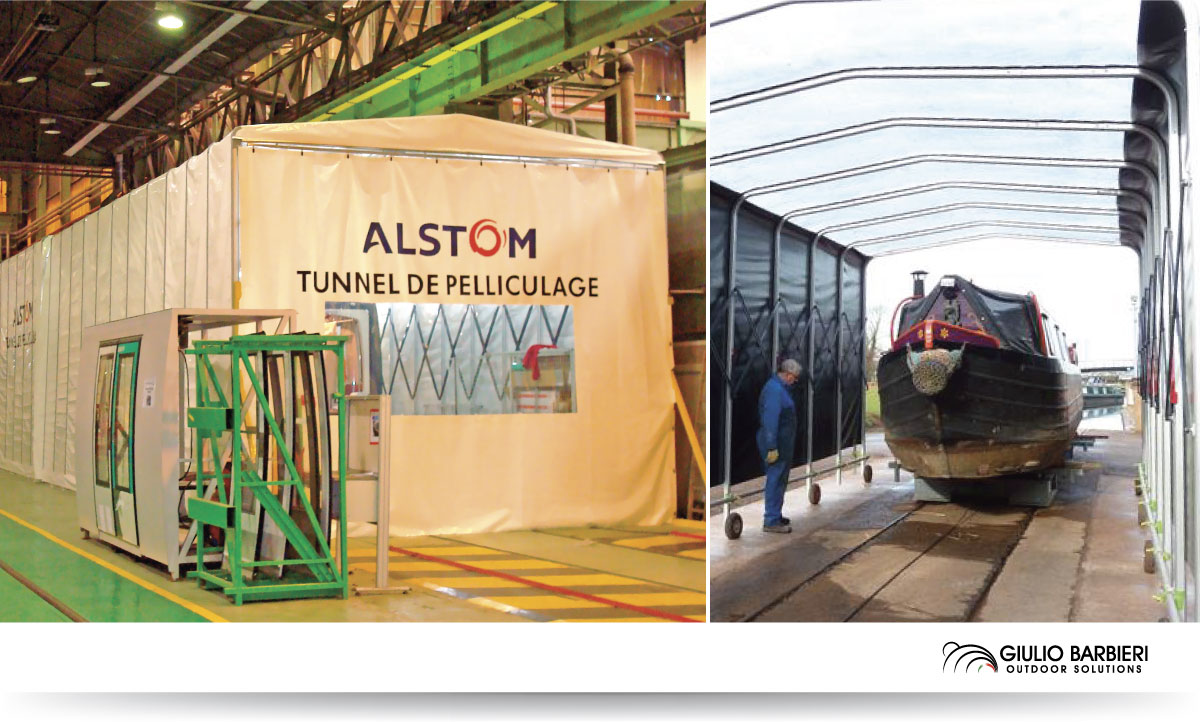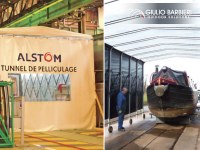How to build a temporary workshop
Types of structures that can be used to create a temporary workshop
The world of temporary structures, the ones that give the greatest flexibility of use, offers a number of possible solutions. Below you can learn about a series of methods used to build temporary work areas:
Now let's look at these solutions in more detail.
Temporary buildings
Temporary buildings are specifically designed iron, steel, or aluminium structures covered with PVC fabrics or sandwich panels. They also come in large sizes.
These types of structures are called temporary because they can be assembled and removed in just a few days. As a rule, they are mainly used as warehouses or production areas dedicated to long-term work.
Temporary buildings on wheels
If your requirement for a temporary workshop is limited to a short period of a few months or, for example, a few days a week, the ideal solution for you might be a temporary building on wheels.
These retractable tunnels with PVC sheet covering can be opened and closed in just a few minutes, freeing up room for other purposes and optimising the use of space.

These structures are typically used when carrying out construction works to contain dust. In this case, it is possible to set up one of these retractable tunnels inside the pre-existent production areas and connect to a ventilation system. This will help to prevent the dust from contaminating the clean work areas. But the opposite works too: a retractable tunnel can be useful in those cases where there is a need to work in an isolated and cleaner environment than the surrounding one. Once the work is done, it is possible to close the tunnel freeing up space for other purposes.
A retractable tunnel can also be used for other purposes. For example, if you want to protect the goods being processed while passing from one warehouse to another, as it happens when the goods are freshly painted. In this case, the tunnel will protect the goods passing through and free up the area immediately afterwards, optimising the space dedicated to internal logistics. Other possible applications include providing shelter for loading and unloading areas, road construction sites, outdoor drying areas, such as reinforced concrete moulds, and many other more or less sector-specific activities.
 Download our
Download our
Retractable System catalogue
Inside you will find all the technical specifications
and many examples of use.
Discover the utmost versatility of our temporary buildings: you can have a safe protection from the weather only where and when you want to optimise the space without hindering your production activity.
How to choose a temporary building?
Focus on materials and safety
Pay particular attention to the choice of materials, which must be of the highest quality. They can deteriorate rapidly if regular maintenance is not carried out. This is especially relevant in the case of iron structures. Disposal costs must also be taken into account during the assessment phase: for example, aluminium structures can be fully recycled and this could represent a partial return on the initial investment. As for the PVC sheets, if they are not materials of professional quality, they can easily tear or get damaged, in addition to being flammable and representing a real fire hazard.
We would, therefore, strongly recommend choosing structures made of durable, resistant materials and equipped with all the certificates required by the European safety standards.
PVC sheet: is it better to use a single sheet or one divided into several parts?
We also suggest choosing structures with the sheets divided into several sections, so as to allow easy and economical replacement in case of damage.
Retractable tunnels on wheels: with or without a motor?
If you wish to opt for a retractable tunnel on wheels, keep in mind that if they are heavy iron structures, they usually have to be operated by a motorised system which must be checked regularly to ensure their correct operation and which can turn out to be their weak point.
In this case, we would also suggest choosing aluminium structures, as they don't require maintenance. They are lightweight and have a high resistance to loads, which allows for easy manual handling and reduces any potential operating problems.
Pre-fitted containers
Pre-fitted containers are the first solution for building a small temporary workshop. They are fully customisable and offer the possibility of installing any type of equipment inside them. However, they also have their shortcomings, such as the limited dimensions and the fact that they cannot be dismantled when not in use.
Inflatable workshops
Another solution available on the market, inflatable workshops come with all the limitations of PVC membranes of which they are made. This type of product is usually used for touring sporting events or to create temporary painting booths, so they generally clear of any equipment that could damage the PVC surfaces.
Advantages of a temporary workshop
Whatever temporary solution you decide to adopt as an alternative to a permanent structure, you should always consider the following advantages:
- Low and controlled costs: the first advantage concerns the economic aspect. The construction of a permanent brick or metal structure can involve some serious expenses which very often, due to the complexity of the work, differ from the initial estimate. On the contrary, a temporary structure generally entails lower and clearly outlined costs right from the preliminary stage. In addition to this, in the majority of Italian municipalities, temporary structures without foundations can be installed without requiring costly building permits.
- Quick construction times: as is often the case, when there is a need to add a production area to an already operational company, or simply to start one up quickly, temporary constructions are the winning choice as they can be installed in just a few days.
- Maximum flexibility and versatility: another aspect to consider is the possibility of quickly dismantling the temporary workshop and moving it according to the needs of internal logistics. Unlike a temporary structure, intended for sale or demolition when it is no longer needed, temporary workshops can be reused effectively and efficiently, helping with any future reorganisation of production processes.
Conclusions
As we saw in this article, there is no single solution for every type of activity you wish to carry out.
Several factors can contribute to the final choice: the size of the area to cover, how the environment should be set up depending on the activities that will be carried out, the time of use and the availability of space in relation to the internal logistics of the entire production plant. Last but not least, the budget available to carry out the work.
In conclusion, our advice is to create a clear list of priorities and make your choice with the long-term outcomes in mind, considering all the maintenance costs that you will have to face over time and the disposal costs you will have to cover at the end of the structure's life.

